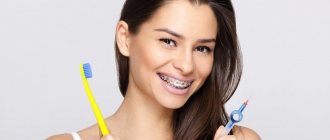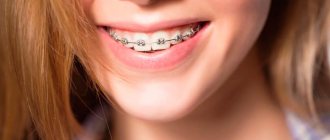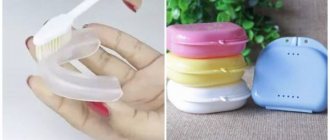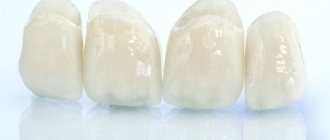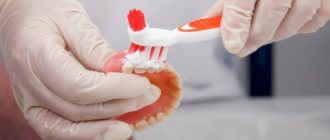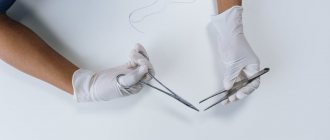The brushes are included in the kit for caring for teeth with braces.
Externally, this brush has an elongated handle and a removable elongated head. This device is very effective for hard to reach places. Removing tiny food particles helps prevent tooth decay and other diseases.
On sale you can find brushes with several interchangeable nozzles of different lengths. The longer ones are for the front incisors, and the shorter ones are for the back molars. In addition, they may vary in the stiffness of the bristles. Dentiki doctors recommend replacing tips after two weeks of use.
When moving, you should be careful when pressing so as not to injure the gums.
Other devices
We include two auxiliary tools in this category:
- Irrigator. It delivers a thin stream of water or solution under pressure, which “knocks out” food particles.
- Flosses. This is a convenient device for using dental floss. The best thread is fluorine-containing, waxed. This strengthens the enamel and prevents the appearance of caries.
All about braces care
- How to care for braces after installation?
- Minimum contents of a braces care kit
- Basic rules for caring for teeth with braces
- What braces care products do orthodontists recommend using?
- Orthodontic wax and irrigator: additional elements of the standard set
- Features of caring for sapphire braces
The procedure for straightening teeth and correcting bite is considered one of the longest and most difficult in dental practice. The bracket system is quite expensive, and without regular maintenance it will require replacement before the end of its intended service life. That is why it is necessary to strictly adhere to hygiene rules and do not forget to clean your braces daily.
Of course, there is always a risk of physical damage to an expensive structure due to an impact, but much more often the consumption of “forbidden” food leads to deformation. Any sticky or hard foods should be completely excluded from the diet. Taffy, caramel and chewing gum are especially dangerous. Tiny particles can get behind structural elements and begin to attract the remains of other food. Over time, plaque forms behind the ligatures.
What types of irrigators are there?
An irrigator is a device that, by creating a pulsating stream of water, cleans the teeth, gums and tongue. Such devices began to be produced relatively recently, but every year they become more and more popular. Today they are recommended to their dental patients. Irrigators help maintain healthy teeth and gums, protecting against caries, periodontal disease, plaque, tartar, gingivitis and other problems. They are also suitable for caring for orthodontic structures: braces, implants, crowns, bridges and dentures.
There are three types of irrigators:
- flow-through;
- stationary;
- portable.
The first ones do not have a liquid reservoir. They are connected by a tube directly to the tap. These are the very first models that are now rarely used. Stationary and portable are equipped with water tanks. They are multifunctional, with several operating modes. These irrigators have a power switch that allows you to regulate the pressure and pressure of the jet. Portable and stationary devices can be used by almost everyone without restrictions: children, patients with sensitive gums, as well as people who have braces installed.
How to care for braces after installation?
A professional orthodontist must teach his patient how to properly clean the braces. Teeth under dirty metal structures can deteriorate very quickly, so it is necessary to pay attention to oral hygiene on a daily basis. Caring for braces after installation involves thoroughly removing plaque and (if possible) disinfecting metal elements. An electric toothbrush with special attachments will do the best job of cleaning orthodontic arches, rings and ligatures. Alternatively, you can purchase a regular brush with medium-hard artificial bristles.
First of all, you need to remove the removable rubber bands and thoroughly brush your teeth, then place the brush at an angle of 45 degrees to the jaw. The bristles should completely cover the ligature. You need to spend at least ten seconds on each tooth. In order to clean the braces from the inside of the jaw, you will need a special V-shaped single-tuft brush. After all the metal elements are perfectly clean, you need to take a special wax and lubricate all the places where the braces come into contact with the mucous membranes (including the interdental space). For greater convenience, you can use a special thin brush.
Devices for cleaning bracket systems
Braces are available from different materials. These are metal, ceramics, medical sapphires. Each system has hard-to-reach places, as well as elements that require careful handling. Rough cleaning of the structure will damage the braces and even the enamel, so it is important to follow the advice of orthodontists and use the recommended devices. Among them:
- Ortho brush.
- Mono-beam (single-beam) brush.
- Interdental dental brush.
- Superfloss, floss, threads for cleaning teeth.
- Irrigator.
In addition to toothbrushes you will need:
- Toothpaste – regular or orthodontic.
- Foams for cleaning braces.
- Mouthwash – for gums and teeth.
- Solution for irrigator – with antibacterial effect.
Additionally, orthodontists include wax in the kit for patients. Its task is to protect the oral mucosa from injury by hard and protruding segments of the brace system.
V-shaped orthodontic brush
The ortho brush differs from the classic height of the bristles - elongated around the perimeter and short in the middle. This arrangement improves the quality of teeth cleaning. With horizontal movements of the orthobrush along the jaw line, the central rows of bristles clean the clasps and arch, and the bristles along the edges clean the interdental space and open areas of the teeth.
There are several things to consider when choosing an orthodontic brush. The product must have:
- soft pile;
- good thickness;
- head sizes up to 3 cm.
Compactness guarantees maneuverability and access to all teeth, and the soft bristles do not harm the enamel of the orthodontic structure.
Mono-beam brush
The single-tuft brush is designed for targeted cleaning of hard-to-reach areas. The product has a curved L-shaped handle and a small tuft of bristles at the end. The beam is made in such a way that when cleaning it completely covers the neck of the tooth.
Rodikova Tatyana
It is better to take mono-tuft brushes with soft bristles. And you don’t need to be afraid that they don’t clean well. At the appointment, I teach how to use this tool correctly, so the quality of care for my patients is always excellent.
Can I clean my braces with a regular or electric toothbrush?
A classic toothbrush is prohibited while wearing braces. You can clean it, but it will not do any good. Removal of dirt will be superficial, and hard-to-reach areas will remain uncleaned.
As for electric models, they can be used, but with reservations. Rotary and sonic electric brushes with soft bristles or orthodontic attachments are permitted. Ultrasonic options cannot be used, since the aggressive influence of ultrasound negatively affects the structure of the adhesive composition and can easily cause damage to the corrective structure.
You can return to using electric toothbrushes after removing your braces.
Orthodontic interdental brushes
Brushes are small brushes with short bristles. There are three product options in orthodontics:
- cylindrical - uniform height of bristles arranged in a spiral relative to the axis of the structure;
- cone-shaped - short villi at the top and elongated at the base of the brush;
- curved - the working part is located at an angle to the handle.
Angled and cone-shaped brushes clean best, but cylindrical ones are also allowed. The device perfectly removes plaque around the braces, under the arches and between the teeth.
The bristles of the brush and the areas between them quickly become dirty, so you should change the brushes every two weeks.
Dental floss for cleaning braces - floss or super-floss
For thorough cleaning of the brace system, doctors recommend superfloss. This dental floss has rigid ends, which makes it easier to pull under the archwire, and has a complex structure that guarantees high-quality cleaning. The second option is waxed floss for cleaning teeth, which glides and does not cling to braces. Otherwise, dental floss is selected as usual - according to manufacturer and thickness.
Plaksina Margarita
I recommend super floss to my patients. This is a fixed size thread with a hard tip. Moreover, it has variable thickness and areas with a spongy structure, which allows it to literally absorb plaque and clean tooth enamel well.
Oral irrigator
An irrigator is a device that cleans teeth with a narrow directed jet released under a certain pressure. When choosing a model, you should pay attention to:
- Type – compact with batteries and a compartment for water or bulky stationary with mains power.
- Pressure – permissible adjustment in the range of 0.7-4.8 bar.
- Modes – types and quantities.
- Variety of attachments.
- Compact size.
Irrigators perfectly clean interdental areas and hard-to-reach areas of orthodontic structures, but do not replace toothbrushes. This is a helper tool.
Toothpastes – orthodontic and plain
Orthodontists give the following recommendations regarding toothpastes:
- During the first weeks after installing braces, avoid products containing high amounts of calcium and fluoride.
- After the enamel gets used to the presence of the corrective structure, give preference to fluoride-containing pastes.
- Buy enzyme-containing formulations to quickly break down food debris and reduce the rate of appearance of pathogenic microflora during the day.
It is also allowed to use familiar toothpastes - the choice is up to the patient.
Foams and gels - quick cleaning of braces
Dental foams and gels can create additional antibacterial protection and quickly remove plaque from teeth. The products have a thick, dense consistency and are well applied to orthodontic structures. These are excellent preventative agents for preventing the formation of caries and tartar.
Foams and gels are a solution for quick hygiene. For use on the road, at work, at school, on a trip - when you don’t have a toothbrush with you.
Dolotova Marina
Many patients are surprised that there are such wonderful foams. They are really comfortable. The consistency is like a gel. They clean perfectly and have an excellent antibacterial effect. Especially indicated for children who cannot brush their teeth after school breakfasts and lunches.
Mouth rinses
Rinsing your mouth after eating and brushing your teeth is a necessity. Especially if it is not possible to carry out proper care and brush your teeth. Special means act comprehensively:
- freshen breath;
- destroy pathogenic microflora in the oral cavity;
- protect against caries;
- reduce the risk of inflammation.
Minimum contents of a braces care kit
Careful oral hygiene is an integral part of caring for your braces. After installing an orthodontic device, you will have to brush your teeth not only in the morning and evening, but also after every meal. You will need a whole arsenal of accessories and special products in order to provide complete care for teeth with braces. The minimum required is:
- V-shaped toothbrush;
- toothpaste;
- waxed dental floss;
- floss toothpicks, or interdental brushes,
- monotuft brush;
- pocket mirror.
It is best to purchase a ready-made orthodontic kit. A braces care kit usually comes with a cosmetic bag or a small plastic box. This kit is very convenient to carry with you and can be used after every meal, even outside the home.
What to do if your braces chafe?
For inflammation of the mucous membranes, you can use special gels and ointments that have an antiseptic and soothing effect - for example, Metrogyl Denta, Vinilin.
To prevent inflammation, it is also recommended to use orthodontic wax. The purpose of its use is to isolate and protect soft mucous membranes from solid elements of the system. Apply to sharp protruding parts and replace as they fall off. It is recommended to remove the wax while eating.
Silicone strips for braces, like wax, are used to protect soft mucous membranes. Silicone is presented in the form of strips that can be used to cover one bracket or the entire row. Unlike wax, it does not crumble and is used repeatedly.
Basic rules for caring for teeth with braces
As mentioned above, proper care of the braces system begins with brushing your teeth. Using circular movements, it is necessary to clean each tooth from the outside and back. When using an electric toothbrush, it is strictly forbidden to press the head too hard against metal elements. This risks causing the bristles to break out and get stuck in the ligatures.
Next, you need to use a floss toothpick or a special brush to remove plaque from the interdental spaces. But to remove food debris directly from under the braces, waxed dental floss is suitable. To clean, you need to tear off about 30 centimeters of thread and carefully insert it under the staple. Then pull the thread under the rings and holes in the locks and make several cleaning movements. Repeat the procedure with each tooth. Next, you can begin to carry out the above-described care program directly for braces, after rinsing your mouth with salt water or a special solution.
Cleaning technique
While wearing braces, it is important to follow the rules of brushing your teeth. Special brushes help prevent caries and the development of harmful microbes, but only when used correctly.
Rules for using orthodontic device products:
- At the beginning of the hygiene procedure, use a brush with bristles in the shape of the letter V. The paste should be applied to dry bristles. Then they begin to move the brush horizontally. The front teeth are brushed first, and then the side teeth. Using sweeping movements, the brush is directed from the gum line to the cutting edge.
- Then you need to take a single-beam model. Using this product, you should clean the surface of each element of the braces and the locking mechanism. Next, the interdental space and chewing surface of the molars are processed.
- The brush is passed under the arch. Then, with rotational movements of the brush, the vestibular surface of the enamel, the orthodontic arch and the area where the bracket system adheres to the tooth are cleaned. During this procedure, it is recommended to make a reciprocating movement vertically.
After using special devices, take a classic brush, which is used to clean the lingual and chewing surface. At the end of the procedure, you should use a dental rinse.
What braces care products do orthodontists recommend using?
As for toothpaste, it is better to give preference to one that contains fluoride and xylitol. You can also choose a mouthwash with a similar composition. Fluoride will help prevent tooth decay, and xylitol will protect against bacteria and germs. Also, xylitol-based products leave a pleasant feeling of coolness, which allows you to forget about the presence of iron braces in your mouth for a while.
As for home remedies, dentists recommend using plain salt water as a rinse. Rapa will quickly relieve pain, which often occurs in the first month after installation of the system, and will also destroy bacteria in the oral cavity. Salt water will help heal sores and cuts that may appear on the gums or the mucous membranes on the inside of the cheek. To prevent damage to mucous membranes, it is better to use professional braces care products.
Diet rules while wearing braces
For effective treatment, you need to adjust your diet.
- Avoid solid foods - tough meats, nuts, raw vegetables and fruits, crackers and other foods that can damage the braces.
- Avoid sweet and sticky foods - chocolate, marmalade, marshmallows, nougat, and chewing gum can stick to your braces. Cleaning the system from such products is a difficult and dangerous task; the locks can be damaged or become unstuck. In addition, large amounts of sugar provoke the growth of bacteria in the oral cavity.
- Avoid foods with dyes—wine, soda, strong tea, or colorful candies can tint your braces an undesirable shade.
- Too cold and hot dishes are prohibited - temperature changes can cause braces to come off.
Orthodontic wax and irrigator: additional elements of the standard set
The use of orthodontic wax can significantly reduce the discomfort caused by metal braces.
Very often, protruding elements of the braces system scratch the delicate tissues of the oral cavity. Wax protects gums, inner lips and cheeks from sores and scratches. The wax is sold in small plastic boxes and has a structure similar to soft chewing gum. Using the product is quite simple: you need to tear off a little wax from the container, warm it in your palms, and then apply directly to the lock or bracket that is causing irritation. Don't worry that some of the wax will be accidentally swallowed, because dental products are non-toxic. Another optional, but very useful device designed to make caring for braces easier is an irrigator. This dental device is used to clean the spaces between braces and teeth. The irrigator acts as a small pump that directs a stream of water to the desired location.
Irrigator for braces - how to choose
When buying an orthodontic irrigator, pay attention to the following points:
- For a family, choose a stationary irrigator with a large number of attachments and a large liquid reservoir. If you often travel on business, a portable model is suitable. However, the kit may not include an attachment for braces. They will have to be purchased additionally.
- Make a choice in favor of models with several operating modes. Such irrigators allow you to change the pressure level and jet pressure.
- Make sure the device is compatible with orthodontic attachments. Even if they are not included, it should be possible to attach them.
There is a separate nozzle for each family member. Typically, manufacturers mark them with different colors so that consumers do not confuse them and use only their own. We will describe popular models and advise which irrigator for braces is best to choose.
What toothbrushes should you buy to care for braces?
For complete care, one v-shaped brush is not enough. In order to be sure that the teeth under the braces system are perfectly cleaned, you need to have several more types of brushes in your arsenal.
Interdental.
This type is used to clean spaces between brackets as well as areas under metal arches. Interdental brushes are available in different sizes, so they can also be used for deep cleaning of interdental spaces.
Mono-beam.
The mono-beam brush has a curved shape, thanks to which it can reach even the most difficult to reach places. This type of brush is intended for caring for braces, not teeth. Even the smallest clasps and ligatures will be perfectly clean with daily use of mono-tuft brushes.
It is worth knowing that any type of brush will wear out several times faster. This is due to the fact that when cleaning a metal system, the bristles can be pulled out. Therefore, you will have to change all care accessories much more often than recommended on the package.
Reviews of orthodontic products
Information about brushes that are produced for cleaning braces can be found on the Internet. People who wear such devices use different products.
For a long time I was afraid to get braces. What scared me was that they are difficult to care for, and the wrong brush can even ruin them. I first consulted with an orthodontist about this issue. He advised several options. I immediately abandoned the electric model. I used one like this as a teenager, but I didn’t like it. Therefore, I purchased a dental brush and a regular brush from Oral B. To prevent food debris from remaining in the braces, I always brush my teeth after eating.
Tatiana
When I got braces at school, I didn’t think to get special brushes. Due to the usual models, several wires were damaged, which were bent in different directions. I often had to go to the doctor to have everything fixed. For some reason, he didn’t say that I needed to use certain products, which I only learned about from the Internet. I threw away the old brush and bought a mono-tuft brush. There were no problems with it while brushing my teeth. I choose models with soft bristles so as not to irritate my gums.
Catherine
I've been wearing braces for six months now.
The orthodontist immediately said that I needed to use special brushes, but I didn’t listen to him. For the first week, I brushed my teeth normally, which caused the appliance to constantly move and become damaged in some places. I had to buy a Miradent I-Prox P brush and a special brush. I was very pleased with the results of cleaning with such devices. They quickly clean not only the teeth, but also the braces themselves, which do not deteriorate due to the high-quality bristles. Alyona
Features of caring for sapphire braces
Adult patients prefer polymer materials to metal that is too visible. Sapphire braces are transparent, lightweight and ultra-thin, which allows you to avoid drawing unnecessary attention to your smile. In general, caring for sapphire braces is practically no different from the above rules. However, orthodontists recommend remembering several important nuances. Firstly, it is forbidden to smoke, drink tea and coffee in large quantities. Violating this rule will result in expensive transparent braces acquiring a yellowish tint. You will also have to rinse your mouth not twice a day, but after each meal. After all, any dirt stuck behind the ligatures will be visible to others.
We must not forget that the polymer material is quite fragile. Orthodontists recommend purchasing a special protective mouthguard, which must be worn whenever active sports are planned.
If you adhere to all the above rules, then you don’t have to worry about the condition of your teeth after removing braces.
What to do if the bracket comes off?
This happens quite rarely. And, as a rule, with budget models that are initially poorly fixed, or after some time after using the system. In such a situation, you need to make an appointment with the orthodontist as quickly as possible, or even come without an appointment during his working hours: gluing the plate will only take a few minutes. Metal braces can be re-glued at least 2-3 times. Ceramic or sapphire - also 1-2 times, but you need to look at their general condition.
It is unlikely that the bracket will be swallowed, since even if it comes off the surface, it will still be fixed to the arch with the help of ligatures or locking fastenings. If the plate does fall off, do not throw it away, but be sure to take it with you to your doctor’s appointment.
